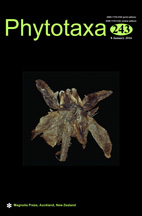Abstract
The Espinhaço Range is a vast chain of mountains comprising ca. 120,000 km2 in the central portions of Minas Gerais and Bahia states, eastern Brazil (Ribeiro et al. 2014). Although this range represents less than 1.5% of the Brazilian territory, it harbors ca. 10% of Brazil’s angiosperm flora (Ribeiro et al. 2012). Furthermore, estimates suggest that ca. 30% of the Espinhaço Range flora is endemic (Giulietti et al. 1987). This high percentage of diversity and endemism may relate to the microhabitat heterogeneity in the “campos rupestres”, a savanna-like vegetation associated with quartzite and ironstone outcrops and white sand patches, at elevations above 900 m (Conceição & Pirani 2005, Ribeiro et al. 2014). The Diamantina Plateau, a quartzite formation of the Espinhaço Range in Minas Gerais, extends from the Araçuaí Basin, in the high Jequitinhonha Basin, to the Rio das Velhas Basin (Ribeiro et al. 2014). The Serra do Cabral, another part of the Espinhaço Range, is a rectangular mountain plateau in the same state in the São Francisco Basin, located to the west of the Diamantina Plateau and separated from it by a valley ca. 40 km wide (Hatschbach et al. 2006).

